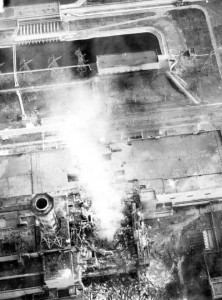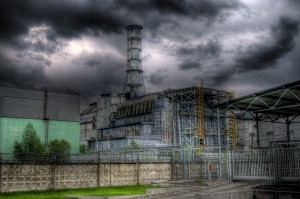In “Chernobyl, My Primeval, Teeming, Irradiated Eden,” Outside writer Henry Shukman tours the site of the world’s worst nuclear power plant disaster 25 years after the massive meltdown. There are some signs of life, though you couldn’t really call them green shoots. An excerpt:
“Today, around 5,000 people work in the Exclusion Zone, which over the years has grown to an area of 1,660 square miles. For one thing, you can’t just switch off a nuclear power plant. Even decommissioned, it requires maintenance, as does the new nuclear-waste storage facility on site. The workers come in for two-week shifts and receive three times normal pay. Any sign of disease at the annual medical, however, and they lose their jobs.
There are also some 300 people living in the zone: villagers who’ve been coming home to their old farming lands since not long after the disaster and teams of radio ecologists from around the world who’ve come to study the effects of radioactive fallout on plants and animals. They’ve effectively turned the zone into a giant radiation lab, a place where the animals are mostly undisturbed, living amid a preindustrial number of humans and a postapocalyptic amount of radioactive strontium and cesium. On the outside the fauna seems to be thriving: there have been huge resurgences in the numbers of large mammals, including gray wolves, brown bears, elk, roe deer, and wild boar present in quantities not recorded for more than a century. The question scientists are trying to answer is what’s happening on the inside: in their bones, and in their very DNA.
 ONCE YOU ENTER THE ZONE, the quiet is a shock. It would be eerie were it not so lovely. The abandoned backstreets of Chernobyl are so overgrown, you can hardly see it’s a town. They’ve turned into dark-green tunnels buzzing with bees, filled with an orchestral score of birdsong, the lanes so narrow that the van pushes aside weeds on both sides as it creeps down them, passing house after house enshrined in forest. Red admirals, peacock butterflies, and some velvety brown lepidoptera are fluttering all over the vegetation. It looks like something out of an old Russian fairy tale.
ONCE YOU ENTER THE ZONE, the quiet is a shock. It would be eerie were it not so lovely. The abandoned backstreets of Chernobyl are so overgrown, you can hardly see it’s a town. They’ve turned into dark-green tunnels buzzing with bees, filled with an orchestral score of birdsong, the lanes so narrow that the van pushes aside weeds on both sides as it creeps down them, passing house after house enshrined in forest. Red admirals, peacock butterflies, and some velvety brown lepidoptera are fluttering all over the vegetation. It looks like something out of an old Russian fairy tale.
Ukraine officially opened Chernobyl up to tourism in January 2011, but small groups have been able to visit the zone for the past few years. There are small tour operators based in Kiev that take visitors on day trips. You don’t need Geiger counters or special suits; you just have to stay with the tour, pass through several checkpoints, and get tested for radiation on your way out. The tours will shuttle you around some of the main sites—the deserted city of Pripyat, a small park filled with old Soviet army vehicles used in the cleanup, various concrete memorials to the fire crews who lost their lives after the blast. Visitors are strictly confined to areas the author ities have scanned and declared safe.” (Thanks Longreads.)
Tags: Henry Shukman

